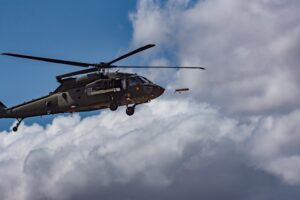The Army will select by the end of 2021 which prototypes will move forward from its new program to develop Air Launched Effects (ALE) for its future helicopter fleet, the program office told Defense Daily.
Formal testing for the air vehicles, mission systems and payloads developed under the ALE program is scheduled to take place in the first three months and last three months of the project.

“A decision to take prototype solutions forward for system and host platform integration will take place at the end of the OTA,” Program Executive Office-Aviation’s Unmanned Aircraft System Project Office said in a statement. OTA is the Other Transaction Authority agreement.
On Tuesday, the Army announced it has awarded 10 deals totaling $29.8 million to a group of companies to work on different aspects of the future drones (Defense Daily, Aug. 25).
ALE is expected to deliver autonomous air vehicles that can be launched from its Future Attack Reconnaissance Aircraft (FARA), or other platforms, and that are capable of penetrating adversaries’ Anti-Access/Area Denial environments (A2/AD).
The program office noted it received 37 total submissions from 30 companies, with the final Other Transaction Authority deals covering 12 to 15 months of work.
“Each vendor has tangible prototypes that will be modified/matured in support of ALE requirements,” the program office said.
Officials are also working the integration schedule for FARA to ensure ALE prototypes will be available to support development of the future scout attack helicopter.
“FARA integration schedules are being coordinated to ensure that an integrated ALE solution will be available to support FARA development and fielding schedules. FARA integration risk will be reduced through the execution of the prototype OTAs through defined requirements for logical and physical carriage interfaces,” the program office told Defense Daily.
The Army previously selected Lockheed Martin‘s [LMT] Sikorsky unit and Textron‘s [TXT] Bell segment to build competitive FARA prototypes (Defense Daily, March 25).